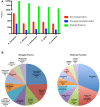Fungal zinc metabolism and its connections to virulence
- PMID: 24133658
- PMCID: PMC3796257
- DOI: 10.3389/fcimb.2013.00065
Fungal zinc metabolism and its connections to virulence
Abstract
Zinc is a ubiquitous metal in all life forms, as it is a structural component of the almost 10% of eukaryotic proteins, which are called zinc-binding proteins. In zinc-limiting conditions such as those found during infection, pathogenic fungi activate the expression of several systems to enhance the uptake of zinc. These systems include ZIP transporters (solute carrier 39 family) and secreted zincophores, which are proteins that are able to chelate zinc. The expression of some fungal zinc uptake systems are regulated by a master regulator (Zap1), first characterized in the yeast Saccharomyces cerevisiae. In this review, we highlight features of zinc uptake and metabolism in human fungal pathogens and aspects of the relationship between proper zinc metabolism and the expression of virulence factors and adaptation to the host habitat.
Keywords: ZAP transcription factor; fungal virulence; zinc ZIP transporters; zinc deprivation; zinc metabolism.
Figures

Similar articles
-
Zap1 regulates zinc homeostasis and modulates virulence in Cryptococcus gattii.PLoS One. 2012;7(8):e43773. doi: 10.1371/journal.pone.0043773. Epub 2012 Aug 20. PLoS One. 2012. PMID: 22916306 Free PMC article.
-
Host Sensing by Pathogenic Fungi.Adv Appl Microbiol. 2018;102:159-221. doi: 10.1016/bs.aambs.2017.10.004. Epub 2017 Dec 7. Adv Appl Microbiol. 2018. PMID: 29680125
-
Metabolism in fungal pathogenesis.Cold Spring Harb Perspect Med. 2014 Sep 4;4(12):a019695. doi: 10.1101/cshperspect.a019695. Cold Spring Harb Perspect Med. 2014. PMID: 25190251 Free PMC article. Review.
-
Hypoxia and gene expression in eukaryotic microbes.Annu Rev Microbiol. 2013;67:291-312. doi: 10.1146/annurev-micro-092412-155658. Epub 2013 Jun 26. Annu Rev Microbiol. 2013. PMID: 23808338 Review.
-
Nitrogen regulation of virulence in clinically prevalent fungal pathogens.FEMS Microbiol Lett. 2013 Aug;345(2):77-84. doi: 10.1111/1574-6968.12181. Epub 2013 Jun 13. FEMS Microbiol Lett. 2013. PMID: 23701678 Review.
Cited by
-
Optimization of Se- and Zn-Enriched Mycelium of Lentinula edodes (Berk.) Pegler as a Dietary Supplement with Immunostimulatory Activity.Nutrients. 2023 Sep 16;15(18):4015. doi: 10.3390/nu15184015. Nutrients. 2023. PMID: 37764798 Free PMC article.
-
Assembly: a resource for assembled genomes at NCBI.Nucleic Acids Res. 2016 Jan 4;44(D1):D73-80. doi: 10.1093/nar/gkv1226. Epub 2015 Nov 17. Nucleic Acids Res. 2016. PMID: 26578580 Free PMC article.
-
Is there an association between zinc and COVID-19-associated mucormycosis? Results of an experimental and clinical study.Mycoses. 2021 Oct;64(10):1291-1297. doi: 10.1111/myc.13365. Epub 2021 Sep 1. Mycoses. 2021. PMID: 34420245 Free PMC article.
-
Insights Into Histoplasma capsulatum Behavior on Zinc Deprivation.Front Cell Infect Microbiol. 2020 Nov 30;10:573097. doi: 10.3389/fcimb.2020.573097. eCollection 2020. Front Cell Infect Microbiol. 2020. PMID: 33330123 Free PMC article.
-
In vitro enrichment of trace elements promotes rapid germination of Aspergillus conidia: a clinical concern for immunosuppressed and hyperglycemic patients.Curr Med Mycol. 2024 Nov 22;10:10: e2024.345251.1549. doi: 10.22034/cmm.2024.345251.1549. eCollection 2024. Curr Med Mycol. 2024. PMID: 40330787 Free PMC article.
References
-
- Amich J., Leal F., Calera J. A. (2009). Repression of the acid ZrfA/ZrfB zinc-uptake system of Aspergillus fumigatus mediated by PacC under neutral, zinc-limiting conditions. Int. Microbiol. 12, 39–47 - PubMed
-
- Amich J., Vicentefranqueira R., Leal F., Calera J. A. (2010). Aspergillus fumigatus survival in alkaline and extreme zinc-limiting environments relies on the induction of a zinc homeostasis system encoded by the zrfC and aspf2 genes. Eukaryotic Cell 9, 424–437 10.1128/EC.00348-09 - DOI - PMC - PubMed
Publication types
MeSH terms
Substances
LinkOut - more resources
Full Text Sources
Other Literature Sources
Medical
Molecular Biology Databases

